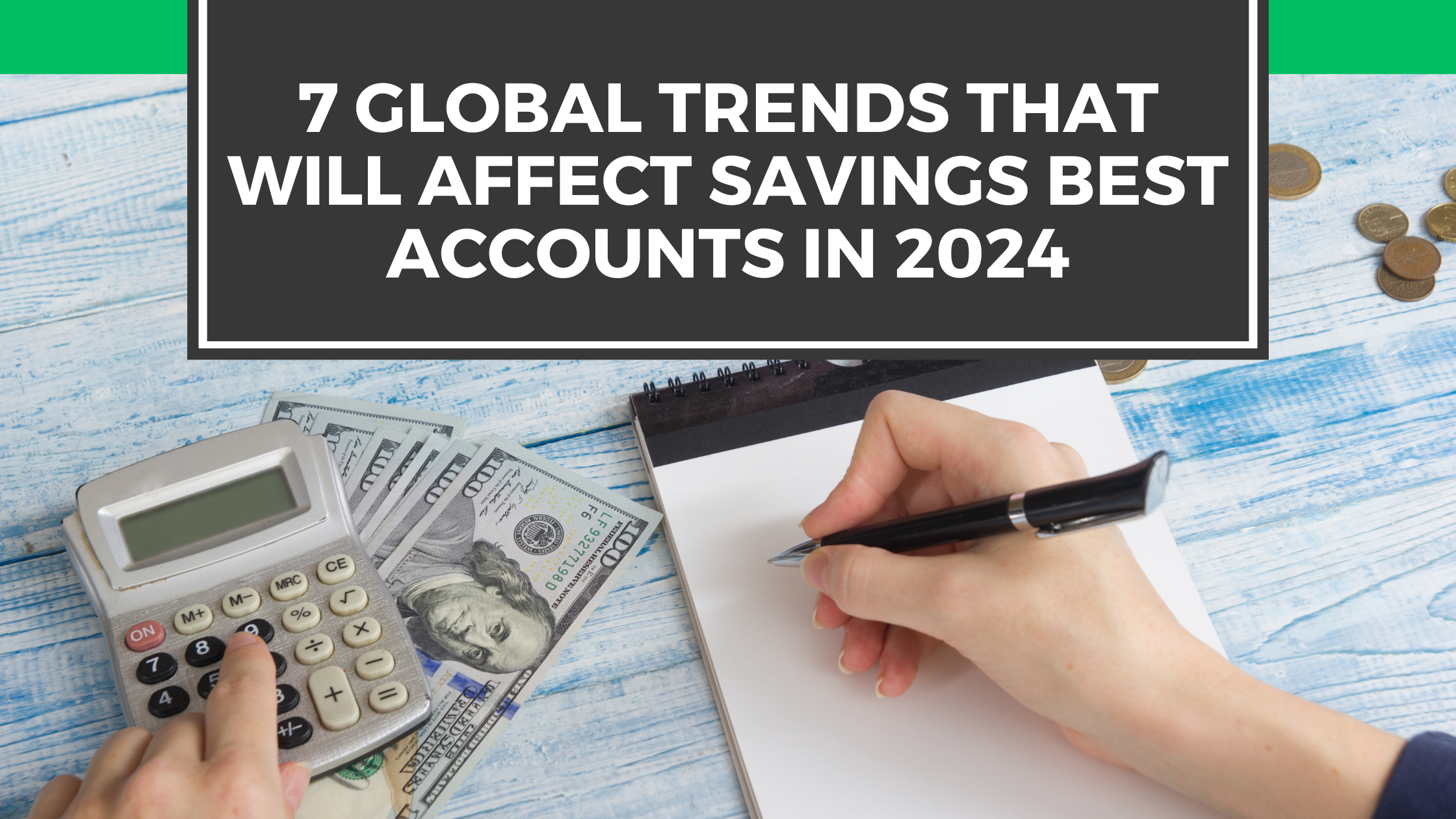So you’re thinking about opening a high-yield savings account to put some money aside for the future. Smart move. Before you dive in and lock in an account, you’ll want to consider how some major trends unfolding around the world could impact savings rates and account options over the next few years. As an informed consumer, keeping an eye on broader shifts that affect banking and interest rates will help ensure you end up with the best savings account for your needs. Here are 7 influential trends that are poised to shape savings accounts in 2024 and beyond. By understanding these forces, you’ll be in the best position to find an account that generates solid returns for your hard-earned cash no matter what the future may hold.
Saving Accounts 101: An Overview of Savings Accounts
So you want to open a savings account but don’t know where to start? Don’t worry, we’ve got you covered. Here’s an overview of the basics.
Savings accounts are deposit accounts where you keep money you don’t need immediate access to. The funds in a savings account can earn you interest over time. The more you deposit, the more you can earn.
Types of Savings Accounts
There are several options to choose from:
- Basic savings accounts have Low or no fees and low-interest rates. Easy to access your money but limited earning potential.
- High-yield savings accounts: Higher interest rates so your money can grow faster. May have higher minimum balances and limited access to funds.
- Money market accounts: Also offer higher interest rates. The limited number of withdrawals allowed per month.
- Certificates of Deposit or CDs: Lock in your money for a fixed term, like 6 months to 5 years, in exchange for the highest interest rates. Early withdrawal penalties apply.
How Interest Works
The interest rate determines how fast your money can grow. Compounding interest, where the interest you earn also earns interest, is one of the most powerful tools for building wealth over time. Even a small amount of interest on a large balance can add up to a lot.
Why Open a Savings Account?
A savings account gives you a safe place to keep your money secure and accessible, with the potential to earn interest. Start with a small deposit and automatic contributions from your paycheck or checking account. Over time, watch your balance and interest earnings grow. Saving money may not seem exciting now, but having a nest egg to fall back on in the future will give you peace of mind. Your future self will thank you.
Factors Driving Changes in Savings Accounts and Rates
As a personal finance writer, I see several factors driving changes in savings accounts and rates in 2024.
Low-Interest Rates
Interest rates have been at historic lows, limiting how much banks can pay in savings account rates. As the economy recovers, the Federal Reserve is expected to raise rates gradually. This means savers may see slightly higher returns on savings in 2024, though rates are unlikely to reach pre-pandemic levels quickly.
More Online-Only Banks
Online banks, also known as virtual or internet-only banks, offer higher interest rates since they have lower overhead costs. More people are banking primarily online, so expect more online-only banks and competitive rates to attract customers. However, make sure any online bank is FDIC-insured for the same protection as a traditional bank.
Mobile Banking
It’s now common for people to handle their banking on the go using mobile apps. Look for more banks optimizing their mobile apps to attract younger customers used to the convenience of mobile banking. Some may offer special rates or perks for customers who use their mobile app.
Green Initiatives
Environmental and social governance (ESG) initiatives are influencing businesses across sectors, including banking. Some banks may promote “green” savings accounts that invest in renewable energy or other sustainable projects. While rates may be slightly lower, it appeals to those who want their money supporting eco-friendly causes.
In summary, while interest rates are still low, improving economic conditions, online and mobile banking trends, and sustainable investing priorities are driving gradual changes in savings accounts and rates. Savers can benefit by shopping around at different banks to find the best deals. Comparing accounts and rates will be key to making the most of your money in 2024.
How Global Economic Trends Will Impact Savings Accounts
The global economy is constantly changing, and trends emerge that can have significant impacts on personal finance. Three major trends, in particular, could affect savings accounts in 2024 and beyond:
The rise of digital currencies
Digital currencies like Bitcoin are gaining more mainstream popularity and acceptance. Some experts predict that in a few years, central banks may issue their own digital currencies. If this happens, it could boost the appeal and value of savings accounts that offer higher interest rates for people willing to be paid in central bank digital currency. The risk, however, is that the value of those digital currencies could drop sharply at any time.
Historically low-interest rates
Interest rates have been at historic lows for over a decade now in many parts of the world. If rates start to rise again in the coming years in response to economic growth and inflation, savings accounts would likely increase their rates to keep up. Your money in the bank would earn more interest, allowing your balances to grow faster. On the other hand, if rates stay low or go even lower, the small amount of interest paid by most savings accounts may not offset the effects of inflation.
A global economic slowdown
There are concerns that the world economy could face a significant slowdown, recession or crisis in the coming years. If that happens, central banks may cut interest rates to try to stimulate growth. While lower rates are bad for savers, a slowing economy also often means lower inflation. Your money in a savings account, even with little interest, would maintain more of its purchasing power. If the economic situation deteriorates severely, savings accounts would still provide security for your money while the stock market and other assets could decline sharply in value.
The bottom line is that savings accounts, while usually considered very low-risk, are still subject to the fluctuations of the overall economy and financial system. Keeping an eye on major global trends can help you make the best choices to protect and grow your money.
Top 7 Ways to Get the Best Savings Account Rates
Getting the best rates on a savings account can help your money grow faster. Here are seven ways to find top savings account rates:
Shop Around at Different Banks
Don’t just go with the bank you already use. Compare rates at different banks, both large and small. Smaller banks sometimes offer higher rates to attract new customers. Check online banks too, since they often have lower overhead costs and can pass savings onto you.
Look for High-Yield Savings Accounts
High-yield savings accounts typically offer higher interest rates than regular savings accounts. The rates on high-yield accounts can vary significantly between banks, so compare rates to find a top option. Some currently offer over 2% APY.
Consider Certificate of Deposits (CDs)
CDs usually offer higher rates than savings accounts. You deposit money for a fixed period, like 6 months to 5 years, and get a guaranteed fixed rate. Longer terms often have the best CD rates. If rates go up, you can withdraw money penalty-free at the end of the term.
Watch for Rate Bumps
Some banks frequently increase rates to stay competitive. Look for a bank that has a history of raising rates to match market increases. That way, your money has the potential to continually earn a top rate.
Look for Bonus Offers
To attract new customers, many banks offer cash bonuses, higher rates for a limited time, or both. These special offers are a great way to earn additional interest or a lump-sum bonus. Make sure you understand any terms before signing up.
Negotiate the Best Deal
Don’t hesitate to contact a bank and ask if they are willing to match or beat another bank’s rate offer. Explain you are rate shopping and willing to move funds for the best deal. Many banks will negotiate to win your business.
Be Flexible
Rates change constantly. Review rates at least every six months and be willing to switch banks if you find a significantly higher rate. A little effort can go a long way toward maximizing your savings returns.

Choosing the Right Savings Account for You
When choosing a savings account, the most important thing is finding one that suits your financial situation and needs. Here are some factors to consider:
Interest Rate
The higher the interest rate, the more your money can grow over time through compounding interest. Shop around at different banks and credit unions for the best rates. Online banks often offer higher rates than traditional brick-and-mortar banks. Consider both high-yield savings accounts and certificates of deposit (CDs) which provide fixed rates for a set period of time.
Fees
Look for a savings account with no monthly fees or maintenance charges which can eat into your returns. Some accounts charge fees if your balance drops below a certain amount, so make sure any minimum balance requirements fit with the amount you want to deposit. Overdraft and ATM fees should also be avoided when possible.
Accessibility
How easily can you access your money? Savings accounts typically allow unlimited penalty-free withdrawals, while CDs usually limit access to your funds for a fixed term. Consider how often you may need to withdraw money when choosing an account. Online accounts provide 24/7 access, while traditional banks have more restricted hours.
Insurance Coverage
Make sure any savings account you consider is FDIC insured for up to $250,000 per account. This ensures you will not lose your principal investment and accrued interest in the event of a bank failure. Credit unions are insured by the NCUA for the same amount.
By evaluating these factors and determining what is most significant for your needs, you can find a savings account that provides the best overall solution. Whether you are saving for short-term goals like a vacation or long-term goals like retirement, choosing the right account for your unique situation is key to helping your money work its hardest for you.
Conclusion
So there you have it, some of the biggest trends on the horizon that are likely to impact the savings account landscape. While the future is always hard to predict with certainty, being aware of these trends means you can make informed decisions about your money and choose accounts that will stand the test of time. The bottom line is that in this era of rapid change, the key is staying up to date with the latest innovations, options, and rates so your hard-earned money works as efficiently as possible for you. Keep learning, and exploring, and don’t be afraid to make a switch if a new account offers a better deal. Your future financial self will thank you for it.




